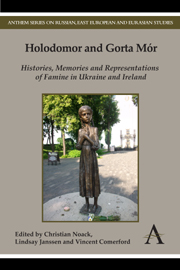Book contents
- Frontmatter
- Contents
- List of Figures
- Acknowledgements
- Introduction Holodomor and Gorta Mór: Histories, Memories and Representations of Famine in Ukraine and Ireland
- Part I Histories, Historiography and Politics
- Part II Public Commemoration
- Part III Trauma and Victimisation
- Chapter 8 Holodomor and the Politics of Memory in Ukraine after Independence
- Chapter 9 The Great Irish Famine in Stories for Children in the Closing Decades of the Twentieth Century
- Chapter 10 Collective Trauma in a Feature Film: Golod-33 as One-of-a-Kind
- Part IV New Sources and New Approaches to the Irish and Ukrainian Famines
- Index
Chapter 9 - The Great Irish Famine in Stories for Children in the Closing Decades of the Twentieth Century
from Part III - Trauma and Victimisation
Published online by Cambridge University Press: 05 May 2013
- Frontmatter
- Contents
- List of Figures
- Acknowledgements
- Introduction Holodomor and Gorta Mór: Histories, Memories and Representations of Famine in Ukraine and Ireland
- Part I Histories, Historiography and Politics
- Part II Public Commemoration
- Part III Trauma and Victimisation
- Chapter 8 Holodomor and the Politics of Memory in Ukraine after Independence
- Chapter 9 The Great Irish Famine in Stories for Children in the Closing Decades of the Twentieth Century
- Chapter 10 Collective Trauma in a Feature Film: Golod-33 as One-of-a-Kind
- Part IV New Sources and New Approaches to the Irish and Ukrainian Famines
- Index
Summary
This essay examines representations of the Great Irish Famine in stories for children written by British and Irish authors towards the end of the twentieth century. The texts, selected from among a large number of publications, represent the best of their kind in this writer's view.
The story of the Great Irish Famine of the 1840s is one of the most problematic episodes in Irish history. It is such an emotive story that efforts to commemorate the 150th anniversary of ‘Black ‘47’ aroused passionate debate in Ireland. The Irish Times printed an angry series of letters arguing that a concert of popular music was not a suitable way to remember the deaths of a million people.
A letter from the British prime minister Tony Blair on the subject was deeply appreciated in Ireland for observations such as these: ‘that one million people should have died in what was then part of one of the richest and most powerful nations in the world is something that causes pain as we reflect on it today’ and ‘those who governed in London at the time failed their people through standing by while a crop failure turned into a massive human tragedy’.
- Type
- Chapter
- Information
- Holodomor and Gorta MórHistories, Memories and Representations of Famine in Ukraine and Ireland, pp. 189 - 196Publisher: Anthem PressPrint publication year: 2012



